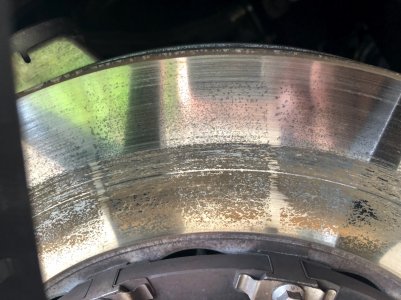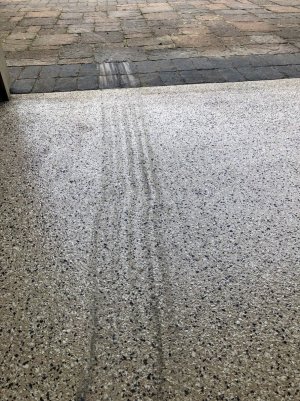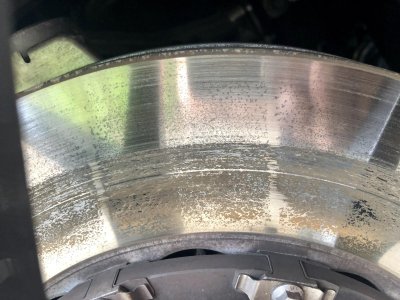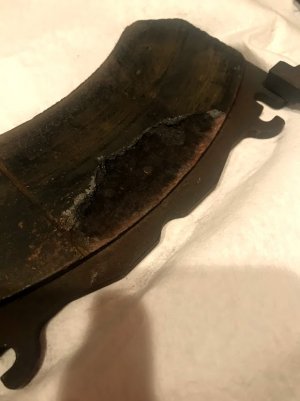My 2018 NSX has seized rear brakes - it seems the main brakes versus the ebrakes - and the car will not move. I drove the car last about 2 weeks ago and went to drive it this evening. The car started and when I put it into reverse and touched the accelerator, the car didn't move and the revs increased only a couple of hundred RPM. I set and released the parking brake a few times - no change. I put the car into neutral and tried to roll it - nothing doing. No warning lights. Has anyone else had a similar problem? TIA.
-
Protip: Profile posts are public! Use Conversations to message other members privately. Everyone can see the content of a profile post.
You are using an out of date browser. It may not display this or other websites correctly.
You should upgrade or use an alternative browser.
You should upgrade or use an alternative browser.
Rear brakes seized
- Thread starter TC
- Start date
That seems to be it. The last time I drove my car, it was in a torrential downpour. And I do have the iron rotors. Any suggestion on how to unstick the pads from the rotors? Perhaps it is best for my dealer to come get the car and fix the problem, esp. if new pads and/or rotors are required. Many thanks.
This happens to my 91 if I don't drive it after I wash it. Just punch the gas, it will "unstick" :wink:
This happens to my 91 if I don't drive it after I wash it. Just punch the gas, it will "unstick" :wink:
I tried that when I first tried to drive the car yesterday - the revs increased about 200 RPM from idle and then went back down to idle. I'm thinking the ECU detects that the wheels aren't turning under throttle so it back down the throttle. I tried again this morning and 3 wheels broke loose but one dragged on my wet garage floor for about 10 feet before it finally started to rotate. I drove the car a bit but all four corners bang and shake under even modest braking. The local NSX service specialist says it has to come in for repair. Apparently the reaction between the iron rotors, water and the brake pads produces some type of corrosion that is not the typical surface rust on an iron rotor - which s basically what is stated in the service bulletin that RyanRA shared. While hard to see in the pics, the corrosion on the rotors is several thousands of an inch deep. Thanks again for all of the feedback.
View attachment 162486


Attachments
Last edited:
So the car might need a brake job after driving in the rain. Let no one say Honda hasn't built a true exotic this time.
After having driven it in the thunderstorm, did you park it with the e-brake engaged for those 2 weeks? If so, that could have caused the issue.
No ebrake when it was parked. There were patches of corrosion on all 4 rotors.
No ebrake when it was parked. There were patches of corrosion on all 4 rotors.
Darn, sounds like the rear caliper that didnt get "unstunk" likely has slide pins that wont retract normally and need servicing, or the piston(s) inside the caliper need rebuilding
So the car might need a brake job after driving in the rain. Let no one say Honda hasn't built a true exotic this time.
Well, according to the Acura service bulletin on this issue, after driving in rain the brakes need to be "dried":
"To keep this from happening, the brakes should be dried before parking the vehicle. This is especially important if the vehicle is being put into long-term storage. To dry them, just drive on a dry road for a few miles, applying the brakes as you normally would for those traffic and road conditions."
My wife is having a good laugh at this one - "...haven't cars been able to drive in the rain for a while now?". She also pointed out that if it is raining when I go to park the car, I won't be able to "...just drive on a dry road for a few miles."
I tried that when I first tried to drive the car yesterday - the revs increased about 200 RPM from idle and then went back down to idle. I'm thinking the ECU detects that the wheels aren't turning under throttle so it back down the throttle. I tried again this morning and 3 wheels broke loose but one dragged on my wet garage floor for about 10 feet before it finally started to rotate. I drove the car a bit but all four corners bang and shake under even modest braking. The local NSX service specialist says it has to come in for repair. Apparently the reaction between the iron rotors, water and the brake pads produces some type of corrosion that is not the typical surface rust on an iron rotor - which s basically what is stated in the service bulletin that RyanRA shared. While hard to see in the pics, the corrosion on the rotors is several thousands of an inch deep. Thanks again for all of the feedback.
Wow that's crazy!! Good luck with the repairs.
Whiskey. tango. Foxtrot? I’ve had the same happen in other cars and some thrust fixes the stick wheels, then driving for a few minutes smooths out the brakes. Acura’s solution makes no sense if it’s raining outside.
- Joined
- 3 July 2016
- Messages
- 249
I assume this will be covered under warranty?
I think your wife is spot on with her comments...
I think your wife is spot on with her comments...
Is this something that could be remedied by running a different set of pads? There has to be alternative pad compounds that would not have this reaction with the iron rotors when they get wet.
Is this something that could be remedied by running a different set of pads? There has to be alternative pad compounds that would not have this reaction with the iron rotors when they get wet.
My local NSX tech said the pads have high metallic content so even though the pads aren't touching the rotors when the car is parked, the water between the pads and rotors enables metal from the pads to migrate to the rotors and cause corrosion/buildup. Again, it ins't the usually surface rust on iron rotors, rather metal from the pads that migrates and bonds with the rotors. So a different type/compound of pads would solve the issue. After about 50 miles of driving and increasing levels of braking, the problem has not gone away - the cars bangs and shakes under braking. It is a lot worse under light braking versus hard braking. As per the service bulletin, the rotors need to be replaced or perhaps machined, in order to solve the problem.
lol so am I going to see the nc1 owners first in the parking lot at xpo wiping off their rotors at the crack of dawn:tongue:
I plan to leave a battery-powered hair dryer in my car so I can blow-dry my rotors and pads after driving in the wet :wink:
I plan to leave a battery-powered hair dryer in my car so I can blow-dry my rotors and pads after driving in the wet :wink:
On the rotors for my other car I sent them out to be slotted and dimpled and then cryo treated. The Cryo treating helps them become more durable and heat resistant. This was important since I decided to run a ceramic pad and those do not absorb heat as well as a semi-metallic pad which brings temperatures in the rest of the braking system a bit higher. For performance street use they are great, wouldn't bother with them if you plan to track it at all.
May be worth looking into to prevent future problems. Just doing some slotting may even help to get some of the water to flow away from the pads.
Last edited:
I'd like to believe you'll have at least a few days’ window to dry your irons before your next drive putts you out of commission.
Thanks for sharing, Steve. That's amazing - looks like a 16th of an inch of lost pad material.
I brought my car in for service this morning and just spoke to the NSX service specialist at the dealer - the rotors and pads have to be replaced. The required parts are being express shipped from Ohio. The service tech talked to the factory and was told that it is very important to "stomp on those brakes" before parking the car for any more than a day or two. He did make the point that getting the rotors hot from braking will be enough to dry the brakes, even if the roads are still wet. It will be like an F1 car - smoking (or in this case, steaming) brakes when parked after driving.
I brought my car in for service this morning and just spoke to the NSX service specialist at the dealer - the rotors and pads have to be replaced. The required parts are being express shipped from Ohio. The service tech talked to the factory and was told that it is very important to "stomp on those brakes" before parking the car for any more than a day or two. He did make the point that getting the rotors hot from braking will be enough to dry the brakes, even if the roads are still wet. It will be like an F1 car - smoking (or in this case, steaming) brakes when parked after driving.
Similar threads
- Replies
- 4
- Views
- 867









